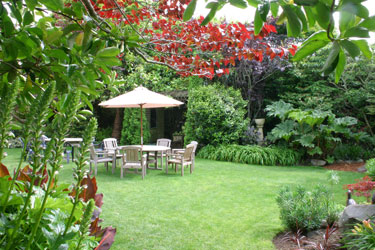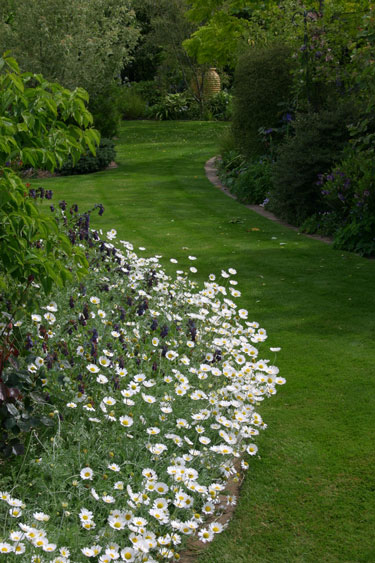Steps to a beautiful lawn
As the days get warmer the lawn leaps back into rapid growth. Spring is a good time to act so that you can enjoy a beautiful green lawn over summer.
Unlike hard surfaces, lawns absorb carbon dioxide from the air and trap dust. In a deluge they combine with other plantings to help reduce water runoff and protect precious soil. Every blade of grass, every tree or shrub adds to the sponginess of our cities, offsetting the concrete jungle as we cope with the impacts of climate change.
And a well-loved lawn is much more than a practical play space. It makes a garden look, smell and feel beautiful, adding a feeling of spaciousness and showing the garden to best advantage. On the other hand a weedy and parched lawn can drag the whole garden down with it.
How much lawn do you need? A lawn that is gorgeously green all year round needs feeding and summer watering. To save time and resources it makes sense to devote attention to a smaller lawn space, while devoting the rest of the garden to low maintenance planting. Small, purposeless areas that are fiddly to mow and those that are over shadowed by trees or too steep to mow safely, may be best given over to alternative groundcovers.
Oversowing
If your lawn starts to go brown in the heat of the summer, it’s dormant, not dead. It will green up again when the rain returns. However about a quarter of your lawn dies away each year, which makes over-sowing a very worthwhile exercise in spring to make a thin or patchy lawn look and feel as good as new.
Use a weed grubber tool to remove large weeds, mow the lawn short, then rake to remove thatch and create shallow grooves in the soil. Add a layer of weed-free topsoil or lawn mix, then scatter the seed and water gently.
Sow what?
As with all plants, it is important to choose the right lawn seed for your soil, climate, and the purpose you want it to serve. A good lawn is never just one grass species, but a carefully considered blend designed for a specific end use. Luckily, all we gardeners have to do is decide what we want from our lawn, grab the right bag, and sow.
Choose hardwearing lawn blends for play and other heavy use areas. A shady lawn needs a balance of shade tolerant grasses, such as fine fescue and tall fescue. Drought tolerance is best in lawns that contain deep rooted grasses like tall fescue. A lawn intended simply to look beautiful may take a little longer to establish but once it gets going, can be surprisingly easy care if sown with a high quality blend of fine fescues.
Patching
When there are bare patches to tend to, a full lawn re-seeding isn ’t necessary. Patches of lawn can die off for many different reasons, including too much sun, not enough water, wear and tear, or pests and diseases. After removing weeds, resow bare and thin patches before new invaders claim their space. To prepare the seed bed, rake strongly to loosen soil and level out any hollows with weed free topsoil or lawn mix. Sow seed into moistened soil, ideally just prior to forecast rain.
Feeding
A well fed, strongly growing lawn will pose minimal weed problems. Apply a balanced lawn fertiliser to make the most ofthe main growth spurts in spring and autumn.
Nitrogen is what a lawn needs most for lush green growth, but a good lawn fertiliser contains the correct proportions of nitrogen and other essential nutrients. Phosphorus is essential for healthy root growth, the foundation of your lawn. Most lawn fertilisers also contain a little iron sulphate to reduce moss, and potassium for disease resistance. Water after applying fertiliser, or time it to coincide with a shower of rain. Apply small amounts of fertiliser, no more than the recommended rate or use a controlled release fertiliser.
For a new lawn, apply a lawn fertiliser to the area and rake it into the top 2cm of soil just prior to sowing. Make sure you choose a product suitable for new lawns and apply it at the recommended rate. Too much can burn the young grass. After the first three or four cuts, make another light application.
Weeding
The best way to keep a lawn free of weeds is to feed it. Weeds love dry hungry lawns. Odd weeds are easily banished using a daisy grubber (a simple, inexpensive hand tool, specially designed for the job), but when weeds get out of hand, spraying is the easiest option. A selective lawn weed spray will take care of the broadleaf weeds without killing the grass.
Watering
In hot summer and autumn weather, the top layer of soil can dry out quickly. Even after a shower of rain, the wind can quickly whip all moisture from the root zone. On established lawns, regular deep watering is the best way to maintain deep healthy roots. How often you water will depend on the weather, the soil type, and your local watering restrictions. For dry climates with summer water restrictions, there are drought tolerant lawn varieties.
Mowing
A freshly mown lawn gives any garden an instant facelift. It is also an important form of pruning; it stimulates branching from the base of each little grass plant, ensuring a close knit, weed-free lawn. Set your mower height to suit the growth rate and your grass type. Fine grasses generally withstand closer mowing than coarse grasses. Mower blades should be no lower than 2cm above ground level, and higher in summer and winter when growth is slow.
Refrain from mowing when the ground is wet as this can make the soil as compact as concrete, and you're more likely to end up with puddles than healthy green lawn.
A 'no-mow' lawn
In hot dry North Canterbury, Jenny Cooper and Chris Raateland have devised a charming way to manage their huge area of lawns without a ride on mower; they only mow what they need for their wide pathways.
They stop mowing their ‘no-mow’ areas in early October when strong grass growth begins, then chop back the long grass April or May when it gets straggly after autumn rains. Then they rake off the hay.
“Within a month you almost can’t see where it was”, says Jenny. The edges and pathways are mowed to give a sense of design and direction. “If it looks intentional, it doesn’t confuse people so much,” Jenny explains.
She suggests to gardeners that they try not mowing a circle of grass, just to see what they have. “Grass seed heads are surprisingly beautiful. Our lawn is just mown sheep paddock!” she says. The long grass out competes most lawn weeds.
Spiking
Any lawn in constant use will eventually suffer from compaction. Once the roots are starved of air no amount of feeding and watering will revive it. If your lawn has become compacted, it can be improved with ‘spiking’: While the ground is damp (but not sodden) use a garden fork to make holes 10cm deep at 15cm intervals. Ease the fork back and forth slightly before removing it. Brush sandy soil into the holes will further improve the aeration. For large areas consider hiring a mechanical corer.
Thatching
Another way to let more air into your lawn is to get rid of the old roots and stems that have built up at the base of the grass. Thatch can be beneficial up to a point, acting as a natural mulch. But when it builds up to over 1.5cm thick it becomes a barrier to water and nutrients, and a disease risk in warmer weather. Excess thatch can be removed by close mowing followed by vigorous raking. Finish with thorough watering and feeding.
Drainage
If your lawn is poorly drained no amount of thatching and spiking will help. On sections where the water lies close to the surface in winter it’s best to install some kind of drainage before sowing a new lawn. Professional advice is often called for, and worth the investment. Alternatively, consider an expanse of decking or a bog garden.
Trouble shooting
- Poor growth in shady areas: Opt for shade tolerant grasses such as fescue. Prune trees to let in more light. Alternatively cover the ground with paving or shade tolerant groundcover plants. Lawn grows best in sun.
- Uneven surface: Carefully peel back a section of turf and fill beneath. Alternatively, fill the hollows with soil or lawn mix and sow seed.
- Moss: Apply Sulphate of Iron or moss killer. Improve drainage and prune trees to let in more light.
- Worm casts: Removing grass clippings and avoiding lime will help keep numbers down. Rake to disperse casts and if practical spread them on the garden, as they're extremely rich in nutrients.
- Clover: Apply a selective lawn weed spray.
- Prickles: Apply prickle weed killer in spring (October) before the flowers form and set seed.
- Dead patches:
- Insect pests and diseases prevail at this time of year. Dig up a small patch to discover the problem. Pests that chew on our lawn roots include grass grubs, black beetle grubs, porina caterpillars. These pests can kill the grass leading to unsightly brown patches. Yates Soil Insect Killer is an easy to use treatment for these pests. Take care to keep children and pets away from any chemicals applied to lawns. Pay attention to safety information given packaging on the packaging.
- Fungus diseases that affect lawns include brown patch, dollar spot, fairy rings, fusarium patch, and red thread. Maintaining a well drained, well fed lawn plus regular removing and removal of lawn clippings are the best ways to prevent these diseases, which are most prevalent in warm humid conditions. For fungal diseases spray as early as possible with a fungicide. Ask at your garden centre for an effective product.
- Yellow patches can also be due to pet urine, other forms of chemical burn such as herbicide or excessive fertiliser.
15-Sep-2023



Jenny Cooper's 'no-mow' lawn and garden


